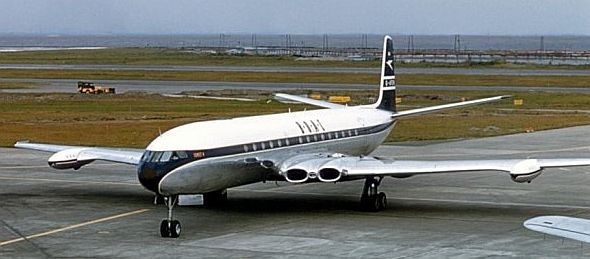Latest Contributions
Read More Contributions
A time to depart for Saat Samundar Paar
Category:

Dr. Anand - an unholy person born in 1932 in the holy town of Nankana Sahib, central Punjab. A lawyer father, a doctor mother. Peripatetic childhood - almost gypsy style. Many schools. Many friends, ranging from a cobbler's son (poorly shod as the proverb goes) to a judge's son. MB from Glancy (now Government) Medical College Amritsar, 1958. Comet 4 to Heathrow, 1960.
Widower. Two children and their families keep an eye on him. He lives alone in a small house with a small garden. Very fat pigeons, occasional sparrows, finches green and gold drop in to the garden, pick a seed or two and fly away.
It was the 29th of January, 1960. My parents had insisted that I spend the day with them and my maternal grandparents in Karnal, before departing from "India". Yes, India as it then was. Not the India I had been born in. "My India" was really Trans-Ravi. One could stretch it to Trans-Sirhind Canal. Sometimes, we Punjabees regarded Sirhind Canal as the boundary between the Punjabi speakers and Hindi Bhasha speakers. It was often just fun, but sometimes ended in anger and in quarrels.
On the evening of 30th January, I caught a flight from Delhi's Palam airport to London's Heathrow airport. (London was Saat Samundar Paar - seven oceans away.) In those days, the airport was very, very quiet. The check-in was very civil. I hugged my parents and my uncle (my father's sister's husband). Shook hands with my cousin. Then, went in through the Departure Gate. Literally on to the airfield.
I had never flown before. The one-way fare was, I think, Rs. 1,800. Quite a bit of money in those days. (The exchange rate was Rs. 13 = £ 1.)
The BOAC Comet 4 had arrived from Australia.

BOAC Comet 4
Later, I learnt that seasoned travelers said BOAC stood for Better On A Camel. In those days, BOAC (now British Airways) was not held in high regard. Air India was highly esteemed by travelers between London and New York.
Comet 4 was a pretty new plane. Not that I knew anything about planes. It was a conveyance. A flying khota (donkey) would have been equally acceptable.
On the airfield, also waiting (among others) to board were a brother and sister, both doctors who had visited their father in Patna\; he had been seriously ill. Then there was a very bulky Brit with a very red face, carrying a big leather bag. He said he was a diplomatic courier taking post from the British High Commission to the Commonwealth Office.
Boarded the plane.
I walked up the aisle to my allotted seat - it was the aisle seat. A lady sat in the next seat. There was a blanket on the seat. "Good evening," I said to my allotted neighbour. "You can't sit here," replied she. Showed, or tried to show, her the boarding card. She was not listening, she was not looking,
There I stood, in the aisle. Cogitating. Along came the Air Hostess. Asked what the problem was. Explained. In a charming but firm voice, she told my esteemed neighbour (she was from Sidney, she told me later) that I was going to sit in my seat. The Sidney Sister - she was middle-aged, but I was young, and even if I do say it myself, I was, then, handsome.
Shortly after the plane took off, the Air Hostess (nowadays demoted to "Stewardess") brought round the menu.
You may find it surprising that we passengers in Economy Class, in 1960, had linen plus stainless steel cutlery and china cups for tea/coffee.
I saw Veal on the menu. My mind went blank. Then it assumed that it was Venison.
I opted for it.
As I ate and enjoyed it, I suddenly clicked. Heavens above, I was eating a baby COW. Too late!
I finished my food and swore I would go to the Gurdwara in London and seek absolution for the sin of eating cow- maata.
The plane flew over Sind, Baluchistan, and landed in Tehran. The first scheduled stop. It was intensely cold even though I wearing a quite unfashionable purposely tailored (in Old Delhi) ankle-length top coat, and my Sheepskin Kashmiri cap like the one Sheikh Abdullah used to wear (purchased from a Muslim clothes shop near Jama Masjid in Delhi.)
Tehran Airport stop was just long enough for me to buy and post a picture postcard to my parents. They did receive it. In those days, post was completely reliable.
The next stop was Damascus - Damashaq as it was known and written, in Urdu in my school days.
I also remember an unscheduled halt in Germany. It was Frankfurt, I believe. Some passengers thought it was to refuel. Dawn was breaking.
The final leg to Heathrow. My Australian neighbour had relaxed a bit since I hauled down one of her little bags from the overhead luggage racks. (My huge moustaches that I sported in those days might have contributed to her initial antipathy.)
As we flew over Southern England and lost height, the landscape was of picture postcard prettiness. This WAS England as I had thought it would look like.
Heathrow Airport, barely a fraction of the size it is today, was also much less busy. And far more civilised than it is today. No problems at the Arrivals Gate. The passport control was simple. They did look at my smallpox vaccination certificate - India was then, an infected country, as it remained for another eighteen years.
A doctor friend was waiting to collect me. We took the BOAC coach to Victoria.
Hello to Blighty.
Farewell to India of the Past.
______________________________________
© Joginder Anand 2017
Comments
Add new comment